All horses are captivating, regardless of their breed or color. Beyond the most common horse colors, there are several rare horse colors that are so beautiful it is hard to believe they exist in real life.
Rare horse colors do not occur randomly but instead are the result of unique color genes that alter the appearance of a horse’s coat. These exquisitely colored horses are rare but undeniably gorgeous.
Learn more about how rare horse colors occur, how to recognize them, and what horse breeds you can expect to find them in.
Table of Contents
1. Cremello
Cremello horses have a gorgeous cream-colored coat, light blue eyes, and white or cream-colored manes and tails. Cremellos are also called double-dilute chestnuts.
The cremello color on a horse develops when a horse that has a chestnut base color inherits the cream dilution color gene from both of its parents.
The double cream dilution gene affects their pigmentation, blanching their natural chestnut coloring to a light cream color.
Cremellos have distinctive light pink skin, also lightened by the cream color gene, most noticeably around their eyes.
Palominos, which are often confused with cremellos, have dark-colored skin, including the skin around their eyes.
Cremellos can be found in several different horse breeds including Tennessee Walking horses, American Quarter horses, Morgans, American Saddlebreds, Thoroughbreds, and Missouri Fox Trotters. (source)
2. Perlino
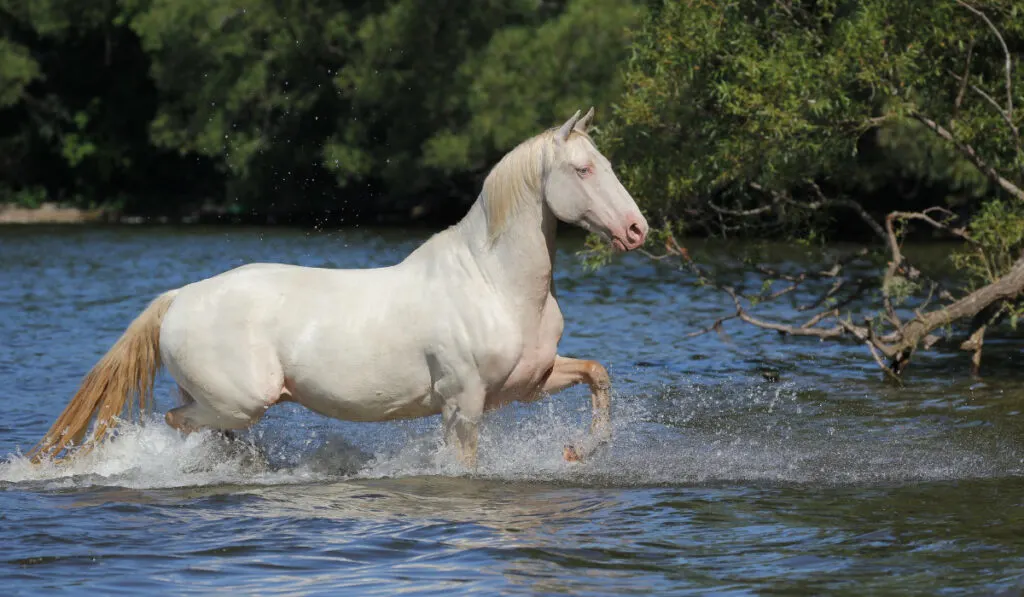
Often confused with cremellos, perlino-colored horses have slightly darker cream-colored coats that have a slight hint of color. Their manes and tails are light-colored but hold a slight red tint.
Perlinos are the result of bay base colored horses inheriting a double dose of the cream dilution gene.
Perlinos have pale blue eyes like cremellos, but they have rosy pink skin instead of pale pink. Their coats will have a minor copper or slight orange coloring.
Sometimes, genetic testing is the only way to know for sure whether a horse is a perlino or a cremello. The test would help identify their base coat color, which would define their true coloration.
Perlinos can be found in the same breeds as cremellos, including the American Quarter Horse, American Saddlebred, the Missouri Fox Trotter, and Tennessee Walking horses. (source)
3. Smoky Cream
Smoky cream horses have a slight smokey or rustic look to their cream-colored coats, darker pink skin, and captivating blue eyes.
Their coloring is the result of a double cream dilution gene on a black base coat. A smoky cream horse retains hints of its natural color in both its coat and hair.
Of course, smoky cream horses are often confused with cremellos and perlino. (source)
Their mane and tails can have a reddish tint, a yellow hue, or even be smoky grey in color.
Horse breeds including the American Quarter horse, Missouri Fox Trotter, Tennessee Walking horses, American Paint horses and American Saddlebreds can all have smoky cream-colored individuals.
4. Pearl
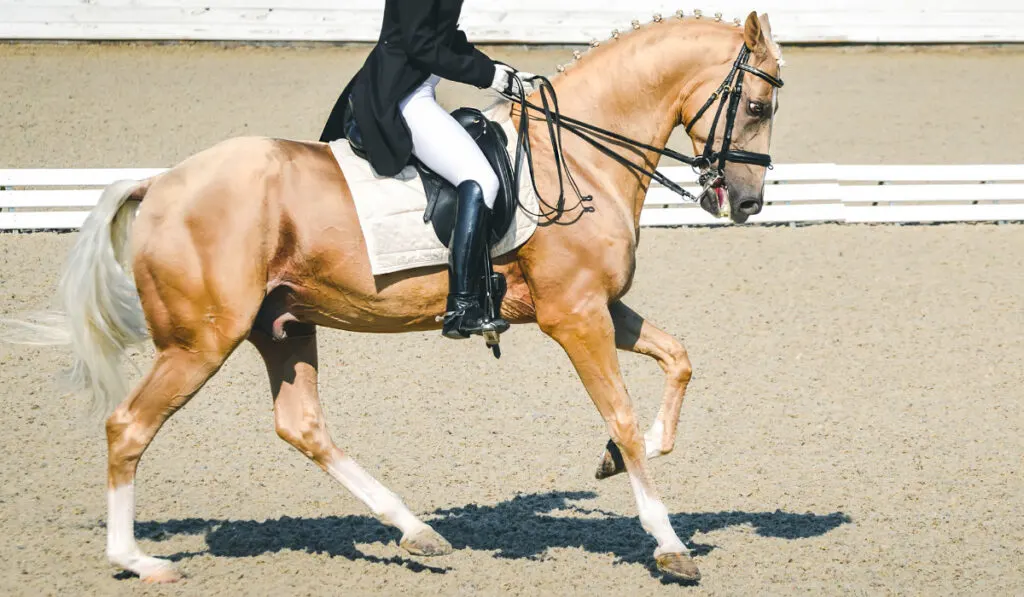
Pearl-colored horses are extremely rare and stunning when seen in person. Pearl-colored horses have gorgeous apricot-shaded coats.
Their hair will also appear apricot-shaded, but slightly darker than their coats. Their skin will appear light grey, unlike cream-colored horses. Pearl horses often have blue eyes.
This unique coloration is the result of a double dose of a pearl gene that moderately dilutes a horse’s natural red color, most notably in chestnuts.
The pearl gene only causes a color dilution in an offspring if both parents carry it, making it a recessive trait.
The pearl color can be easily confused with the champagne coloration, and the only way to distinguish them for sure is through a genetic blood test.
The pearl horse color gene can be found in breeds like American Quarter horses, American Paint horses, Andalusians, and Lusitanos. The pearl gene is also often referred to as the barlink factor. (source)
5. Champagne
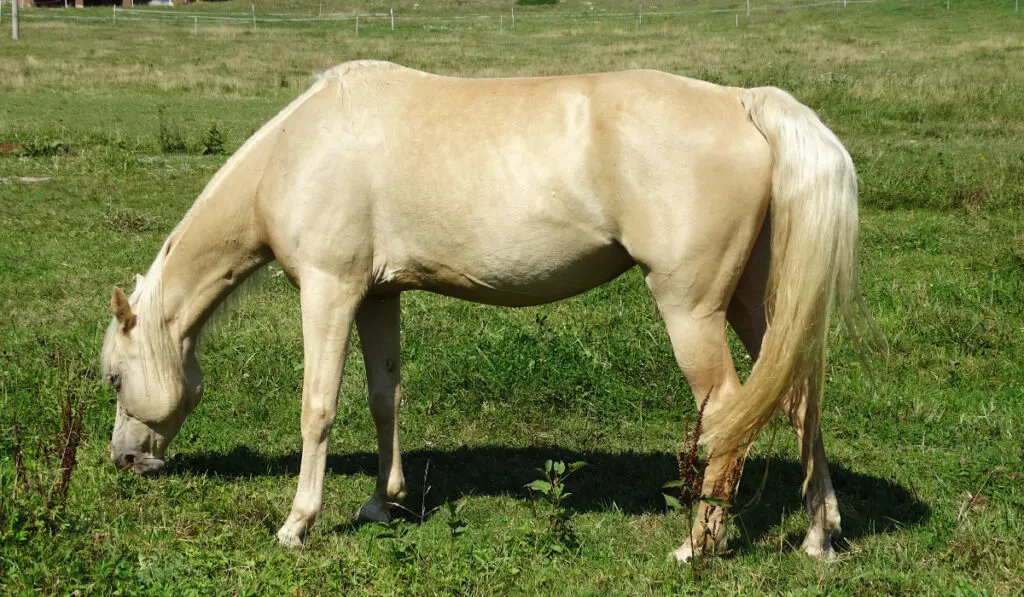
Champagne horses can have coats in variety of shades including gold, amber, seal brown, sable and black champagne. Their specific shade of champagne coloring depends on their inherited base color.
Champagne horses have hazel eyes, pink skin that is also freckled, along with a distinctive coat coloring.
The champagne coloring is caused by an inherited champagne gene that causes a horse’s natural red hair to be gold instead and black hair to be brown.
Gold champagne horses resemble palominos but are distinguishable by their mottled noses.
Champagne colored horses are found in breeds including American Saddlebreds, American Quarter Horses, American Paint Horses, Missouri Fox Trotters, American Cream Drafts, and Appaloosas. (source)
6. Mushroom
Mushroom is a rare and relatively newly understood horse color. Mushroom describes horses that have a unique sepia appearance to their coats.
It is a brownish-gray color that is not exactly brown nor gray. Mushroom-colored horses often have flaxen-colored manes and tails, noticeably lighter in color than their coats.
This appealing color is a result of a mushroom dilution gene that lightens the red tone in a horse’s regular color.
It is more noticeable on chestnut base colored horses. Both parent horses must carry the mushroom gene for a horse to have this unique coloring.
Some equestrians believe that the mushroom gene could be found in breeds like the American Quarter horse, however, it is proven to be found in Shetland ponies and miniature horses. (source)
7. Silver
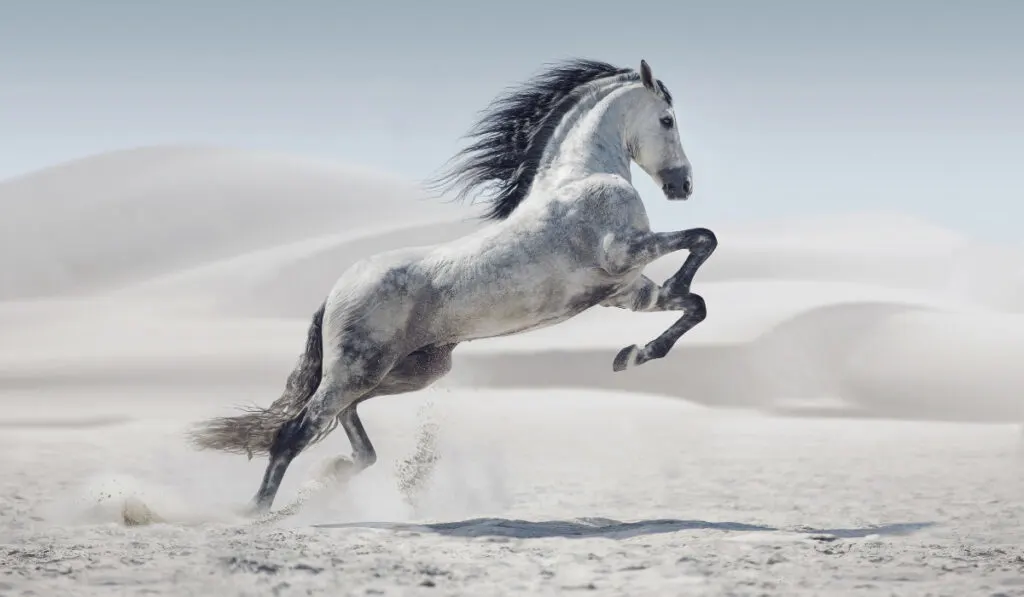
Silver horses have gorgeous, dark-colored coats with striking flaxen or silver-tinted manes and tails.
This rare color is the result of at least one inherited dilution gene lightening a black or bay base coat. It does not affect horses with chestnut base coats even if they carry the gene.
Horses with black bay coats that inherit the silver gene will have chocolate-colored coats with the bright either silver gray or flaxen-colored hair.
Bay base coat horses with the silver gene maintain their base coloring except for the lower part of their legs which are noticeably lighter, almost silver. They will also have flaxen-colored hair.
The silver dilution gene is said to be found in horses of many different breeds including but not limited to Appaloosas, American Quarter horses, Morgans, Kentucky Mountain horses, Swedish Warmbloods, Norwegian Nordlands, and Icelandic horses. (source)
8. Brindle
Brindle coloring in a horse results in stripes of two distinctly different colors or shades.
Considered exceedingly rare, it is said to be related to genetic chimerism, when an animal has cells derived from different zygotes.
This means they can inherit genes for two different coat colorings, resulting in the unique brindle coloring.
It is most noticeable on darker color horses but can occur in light-colored horses as well.
Brindling in horses is not considered an inherited trait, even though it may appear in lineages.
The stripes of coloring are vertical on the horse’s body, but horizontal on their legs. Their heads are usually not affected. (source)
Brindle-colored horses can be found in breeds like the American Quarter horse, Arabians, Tennessee Walking horses, Thoroughbreds, and Russian horses. (source)
9. Leopard
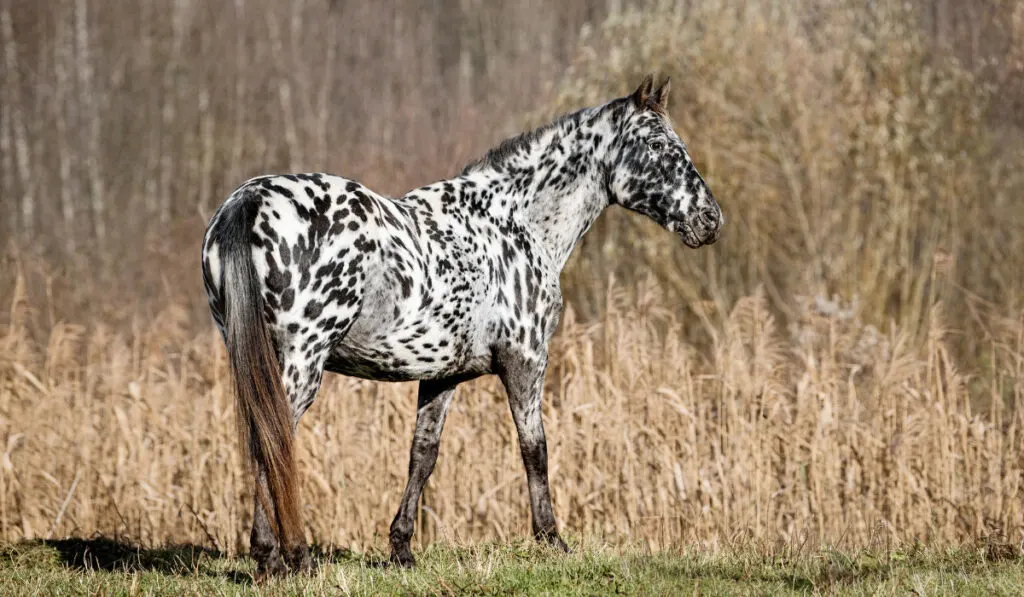
Horses with the leopard complex will have undeniably gorgeous spots of color along with white coloring.
A leopard color in horses is referred to as a leopard complex because it occurs in a variety of varying shades and color combinations.
Some horses have leopard spotting patterns that are so light they are barely recognizable.
The colored spots are the horse’s true base color while the white coloring is the unpigmented area affected by the leopard complex gene.
Leopard spotting in horses tends to occur most often in the hip area. These horses will also have mottled skin around their mouths, noses, eyes, and genitals.
The leopard complex can be found in breeds including the Appaloosa, Knabstrupperer, Karabair, British spotted pony, Noriker, Falabella, and the Mongolian Altai. (source)
Final Thoughts
Some rare horse colors, especially the ones caused by color dilutions, are often easy to confuse with one another.
Now you are better equipped to tell them apart and to identify these uncommon horse colors if you ever get the rare chance to see them in person.

